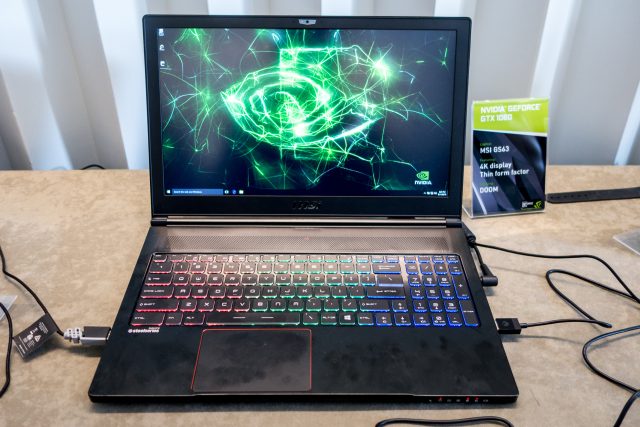
Just under a year since Nvidia brought the full desktop version of the GTX 980 to laptops, it is beginning to put an end to cut-down laptop chips altogether. Starting today, the desktop versions of the GTX 1080, GTX 1070, and GTX 1060—with some very slight tweaks—are inside laptops from the likes of MSI, Asus, Alienware, Lenovo, and Razer, to name but a few. They're even overclockable. Yes, if you want the very best graphics card outside of a Titan X inside something you can carry around with you to LAN parties, Nvidia has you covered.
Well, I say carry around, but just like laptops kitted out with a desktop GTX 980, those with a GTX 1080 inside aren't exactly thin-and-light ultrabooks. Indeed, most laptop makers are reusing the same chassis as they did for the GTX 980, resulting in systems that are insanely thick, heavy, and about as portable as carrying around a sack of bricks. Oh, and don't forget the power adaptor, which—as I saw with some models in performance demos—is literally the size of a brick. But hey, at least if someone tries to mug you for your expensive laptop, you'll have something to clobber the assailant with.
Still, stuffing a desktop GTX 1080 inside a laptop is an impressive technical achievement. The mobile GTX 1080 is based on the same 16nm Pascal architecture GP104 chip as its desktop counterpart, and features the same 2560 CUDA cores, the same 256-bit memory interface, and the same 8GB of GDDR5X memory running at 10GHz for 320GB/s of bandwidth. It's available in both the MXM form factor as well as integrated solutions. The GTX 1080 supports everything the other Pascal cards support too, including recent inventions such as Simultaneous Multi-Projection and Ansel (which you can read more about in our GTX 1080 review), as well as old standbys like G-Sync and GameStream.
| GTX 1080 | GTX 1080 (Laptop) | GTX 1070 | GTX 1070 (Laptop) | GTX 1060 | GTX 1060 (Laptop) | |
|---|---|---|---|---|---|---|
| CUDA Cores | 2,560 | 2,560 | 1,920 | 2,048 | 1,280 | 1,280 |
| Texture Units | 160 | ? | 120 | ? | 80 | ? |
| ROPs | 64 | ? | 64 | ? | 48 | ? |
| Core Clock | 1,607MHz | 1,556MHz | 1,506MHz | 1,442MHz | 1,506MHz | 1,404MHz |
| Boost Clock | 1,733MHz | 1,733MHz | 1,683MHz | 1,645MHz | 1,708MHz | 1,670MHz |
| Memory Bus Width | 256-bit | 256-bit | 256-bit | 256-bit | 192-bit | 192-bit |
| Memory Speed | 10GHz | 10GHz | 8GHz | 8GHz | 8GHz | 8GHz |
| Memory Bandwidth | 320GB/s | 320GB/s | 256GB/s | 256GB/s | 192GB/s | 192GB/s |
| Memory Size | 8GB GDDR5X | 8GB GDDR5X | 8GB GDDR5 | 8GB GDDR5 | 6GB GDDR5 | 6GB GDDR5 |
| TDP | 180W | ? | 150W | ? | 120W | ? |
The concession to mobility comes in the form of a drop in the base clock, which runs at 1556HMz versus the 1607MHz of the desktop chip, although the boost clock runs at the same 1733MHz. How well the GTX 1080 maintains that speed within the confines of a laptop is largely going to depend on the design chops of laptop makers, and Nvidia does note that performance is "within 10 percent of their desktop GPU equivalents," meaning there may be a few small hits to the frame rate here and there.
The GTX 1070 takes a far larger hit to the base clock and boost clock—1442MHz and 1645MHz respectively—but this is largely offset by the increase to 2048 CUDA cores over the 1920 in the desktop part. The 8GB of GDDR5 running at 8GHz remains the same. While I've not had a chance to run any serious benchmarks just yet, a brief test of Rise of the Tomb Raider performed on a chunky MSI GT62 equipped with a GTX 1070 was impressive. The laptop boasted an average frame rate of 103FPS at 1080p on maximum settings and DX12.
Ars' review of the desktop GTX 1070—notably on a beefy six-core system with 32GB of DDR4 RAM and an M.2 SSD—saw the game running at 107FPS. Neat.
Smaller = better
While cramming cards with the performance of the GTX 1080 and GTX 1070 into laptops is an impressive feat—both of these cards are faster than old Titan X, significantly so in the case of GTX 1080—it's the GTX 1060 that's the far more compelling proposition in laptops. The base clock speed has been reduced down to 1404MHz from 1506MHz without any adjustment to CUDA cores, but the smaller, more efficient nature of the GP106 used in the GTX 1060 means it can be crammed into laptops someone might actually want to use.
The best example is the new Razer Blade, which drops the GTX 970M in favour of the GTX 1060 and pairs it with the same excellent 14-inch 3200x1800 IGZO display and relatively svelte 17.9mm aluminium chassis. Similarly, MSI's new GS63 Stealth Pro with GTX 1060 boasts a chassis that's just 17.7mm thick, and weighs 1.9kg. It sports a 15-inch 4K display screen, and its sleek black chassis would look relatively grown up if it wasn't for an unbelievably blingtastic RGB backlit keyboard. Given that the GTX 1060 can happily push over 60FPS at 1080p at maximum settings in nearly every game, that it's inside a laptop you could feasibly carry around in a backpack and use every day is hugely impressive.
-
The new Razer Blade ditches the GTX 970M for the GTX 1060.
-
The Blade remains just as svelte, despite the added graphics oomph.
-
-
With the lid open the MSI is remarkably thin for such a powerful computer.
-
Closed, the MSI is 17.7mm thick.
-
At 1.9KG you can even precariously balance it on one hand while holding a camera in the other.
-
At the chunkier end of the spectrum is Asus' Predator 15.
-
Mmm, impractical.
-
Seeing Gears of War 4 running at a playable 4K resolution on a laptop is impressive.
-
Gears of War 4 has plenty of graphics settings to tweak.
-
The GTX 1070 inside MSI's GT62 performed almost identically to its desktop counterpart.
Unfortunately for Razer, stuffing the likes of the GTX 1060 inside laptops makes external GPU solutions like the Razer Core even more of niche proposition than they were before. Perhaps paired with the thinnest of laptops, where even the likes the GTX 1060 can't go, the Core will still have a place, but it's hard to see a future for such devices when the line between desktop and laptop parts has been removed.
The tradeoff for all that performance is noise and battery life. While much larger and thicker laptops like Clevo's P870DM or Asus' ugly G752VY laptop remained surprisingly cool and quiet under load in demos, both the Razer Blade and the MSI GS63 ran loud and hot. Battery life in the bigger laptops was always going to be terrible, but it'll be interesting to see just what impact the GTX 1060 has on smaller laptops, particularly as it replaces the GTX 960M (the GTX 970M and 980M are also being discontinued). Nvidia hasn't revealed the TDP of the new laptop GPUs, but notes that the GTX 1080 sports a similar TDP to the GTX 980 (160W), the GTX 1070 to the GTX 980M (125W), and GTX 1060 to GTX 970M (around 100W).
Nvidia claims the efficiency improvements of Pascal, most notably with idle power consumption, help boost the battery life of laptops up to 30 percent. BatteryBoost tech makes a return too, which performs clever tricks like limiting the frame rate, or automatically dropping down game settings while running on battery in order to save power. New is BatteryBoost's ability to improve frame variance, reducing stutter and helping to make more efficient use of GPU cycles. That said, performance under battery will take a hit, and Nvidia notes that while its new mobile GPUs are all certified as VR-ready, that only applies when running on mains power, so don't get your hopes up for the ultimate VR backpack PC just yet.
120Hz, 1440p, or 4K?
To go along with its new GPUs, Nvidia has been working with manufacturers to equip their laptops beefier displays. As well as variable refresh rate 1080p G-Sync displays, some laptops will feature 120Hz 1080 G-Sync displays for ultra-smooth, high-frame-rate gaming. Others will feature 1440p panels for the first time (one of which will be also run at 120Hz), which is great match for the GTX 1070 and GTX 1080. There will be 4K G-Sync screens too, and while running games at native 4K at 60FPS is still a stretch for a GTX 1080, performance is leaps and bounds better than previous laptop chips.
I played a preview build of the upcoming Gears of War 4 on a laptop running at native 4K with all the settings cranked and it looked incredible. Such performance would have been unthinkable even just a few months ago, and while the frame rate hovered just below 30FPS, making a few tweaks—including a useful setting that dynamically lowered the resolution during busy scenes to hit a specific frame rate target—made the game more than playable.
Incidentally, those worried that Gears of War 4 might have gimped settings menus thanks to its UWP origins needn't worry—there are a lot of tweaks you can make to the visuals.

If you absolutely want to push 4K with no compromises, there is another option. Like the GTX 980 before it, all of Nvidia's new laptop chips can be overclocked, and Nvidia has packed in dual-FET power delivery and more efficient power controllers to help make it happen. Obviously, given the thermal restraints of laptops, there's far less overclocking headroom than on a desktop, but Nvidia claims boosts of up to 300MHz are possible, depending on the cooling solution. Indeed, Nvidia showed a live demo of an overclocked GTX 1080 inside an MSI laptop running at over 2000MHz during a session of Doom.
Voltage tweaks are still off the table (that would be madness!), and warranty coverage when overclocking will vary depending on the manufacturer, but if there's a performance boost to be had, it's great to have access to it.
The first wave of laptops equipped with the GTX 1080, GTX 1070, and GTX 1060 will be available to order over the next few days, with further models in the coming weeks. Prices will vary wildly, depending on the laptop, but Nvidia says GTX 1060 systems will go as low as $1300 (~£1,100). That's not too bad a price considering that even any laptop with a GTX 1060 is easily the first real no-compromises solution for gaming on the go.
Just one request to all the laptop makers out there: can we please get a 13-inch thin-and-light with a GTX 1060 inside? And if you can make it look like it's for grown ups too, that'd be great.
reader comments
94